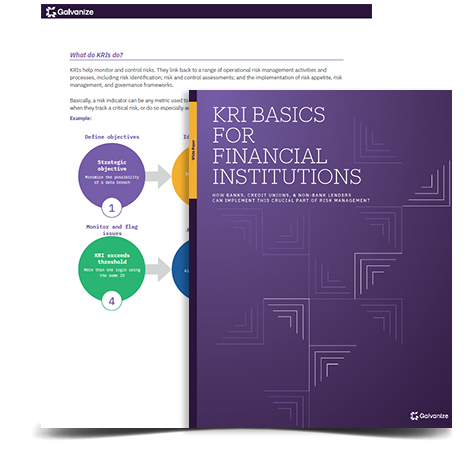Risk management is evolving in the financial services industry. Traditionally, risk management and compliance functions managed risk, but responsibilities are shifting to the front-line.
A Risk in Review study from PwC reveals that a number of leading companies are shifting risk management to the front-line. It strengthens the organization’s risk culture and accountability, and reinforces the defense lineup.
In the banking world, risk is first introduced in the transaction (e.g., when a customer applies for a credit card online). These risks may result in better outcomes and less damage on the front-line than if the same risk is caught later, at your second or third lines of defense. So ideally, banks should aim to identify at least 50% of potential transactional risk and fraud concerns here, at the first line of defense.
Money laundering is the third largest industry after oil and currency, and accounts for billions of dollars in dirty money. Know your customer (KYC) procedures and controls are an essential precaution against these shady activities. And the keys to a successful KYC program are your front-line staff.
So the question becomes: are you valuing your front-line staff to do their jobs?
“By using risk and control self-assessments, you can capture a continuous risk assessment from staff who interact closely with risks and controls every day.”
Front-line staff are best positioned for risk management
Your front-line staff are in the trenches on a daily basis, so they’re in the best position to assess and address transactions from customers.
Shifting focus to the front-lines empowers employees with increased responsibility and ownership (supported by the second and third lines of defense).
Staff can also gather essential risk data. By using risk and control self-assessments (RCSAs), you can capture a continuous risk assessment from these staff.
Benefits of front-line risk management
There are three key advantages of managing risk through your front-line.
- Better accountability and decision making from the ground up.
Using RCSAs equips staff to make better decisions. Since many controls are designed with transactional risk and KYC requirements in mind, data and insights from the point of sale are valuable. Operational staff are in the best position to gauge when things seem a bit off. They can also identify and amend control weaknesses sooner. The added responsibility and empowerment requires staff to exercise professional judgment. An RSCA approach also empowers the front-line with a feedback mechanism to provide additional insight to management for better decision making.
- More agility.
RCSAs are a valuable tool for banks to maintain systematic controls, while also being more agile and responsive to customer needs. Today’s banking landscape has evolved dramatically due to new regulations and red tape. The internet makes customers more information-savvy and aware. This means they expect even more from face-to-face banking interactions. RCSAs help ensure that future customer interactions can be modified quickly when the risks evolve, or customer preferences change.
- Improved customer service.
RCSAs provide strategic knowledge and insights on customer behavior. This translates into better service and happier customers. The data helps improve procedures during customer interactions and enriches the customer journey. Empowered staff who own RCSAs will translate that into a healthier brand and deliver better customer service outcomes.
Risk control self-assessments and HighBond
RCSAs can significantly help your first line of defense become more empowered and risk-aware. Where transaction risk occurs, RCSAs help to ensure there is enough information to understand and address the risk. The first line understands the risks and fixes the issues, while the second line provides validation.
Technology can help you automate and streamline the self-assessment process. At the same time, it frees up your organization’s second and third lines of defense. This fortifies your first line of defense by properly equipping your front-line staff.
HighBond makes it possible for financial institutions to develop and implement effective RCSAs as part of their overall risk management strategy.
White paper:
KRI basics for financial institutions
You’ll learn:
- How KRIs fit into a greater risk management program
- The different kinds of indicators, what they measure, their purpose, and audience
- How to select your own KRIs, including a worksheet
- How to ensure your KRI program is scalable and sustainable.









